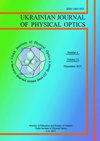掺杂剂浓度和晶体结构对ZnO:Y薄膜吸收边的影响
IF 8.6
4区 物理与天体物理
0 OPTICS
引用次数: 6
摘要
。研究了不同钇掺杂水平的氧化锌薄膜的晶体结构和吸收光谱。使用射频磁控溅射将薄膜沉积在玻璃基板上。我们估计了自由载流子的浓度,并表明随着掺杂水平的增加(高达4.7 wt. %), ZnO:Y薄膜中基本吸收边的“蓝”移可以用Burstein-Moss效应来解释。在较高的钇浓度下,基本吸收边的行为由已知的经验乌尔巴赫规则描述。本文章由计算机程序翻译,如有差异,请以英文原文为准。
Effect of dopant concentration and crystalline structure on the absorption edge in ZnO:Y films
. We study the crystalline structure and absorption spectra for the zinc oxide films with different levels of yttrium doping. The films are deposited on glass substrates, using radio-frequency magnetron sputtering. We estimate the concentration of free charge carriers and show that the ‘blue’ shift of the fundamental absorption edge in ZnO:Y films with increasing doping level (up to 4.7 wt. %) is explained by Burstein–Moss effect. At higher concentrations of yttrium, behaviour of the fundamental absorption edge is described by a known empirical Urbach rule.
求助全文
通过发布文献求助,成功后即可免费获取论文全文。
去求助
来源期刊
CiteScore
9.90
自引率
0.00%
发文量
20
审稿时长
>12 weeks
期刊介绍:
“Ukrainian Journal of Physical Optics” contains original and review articles in the fields of crystal optics, piezo-, electro-, magneto- and acoustooptics, optical properties of solids and liquids in the course of phase transitions, nonlinear optics, holography, singular optics, laser physics, spectroscopy, biooptics, physical principles of operation of optoelectronic devices and systems, which need rapid publication.
The journal was founded in 2000 by the Institute of Physical Optics of the Ministry of Education and Science of Ukraine.

 求助内容:
求助内容: 应助结果提醒方式:
应助结果提醒方式:


